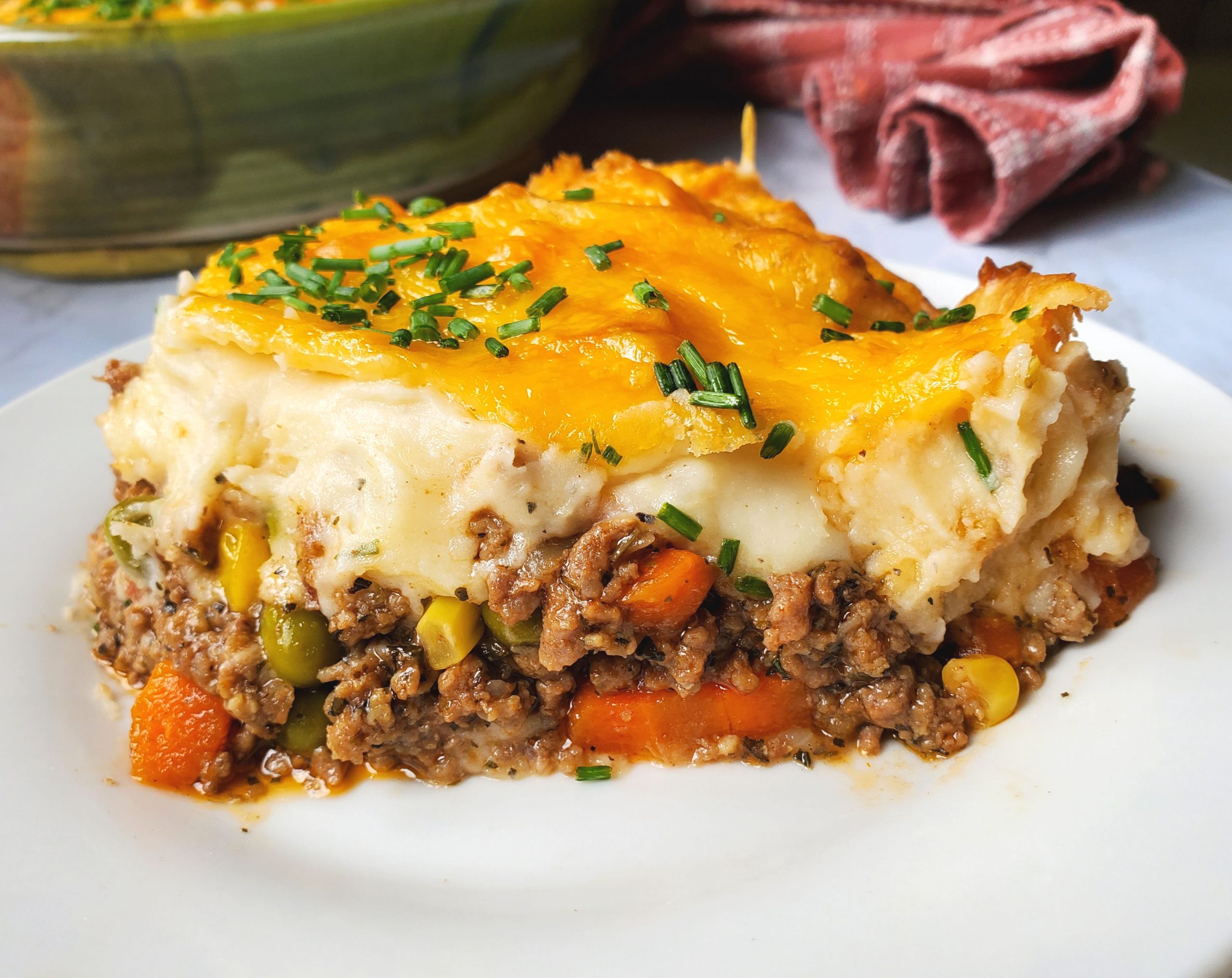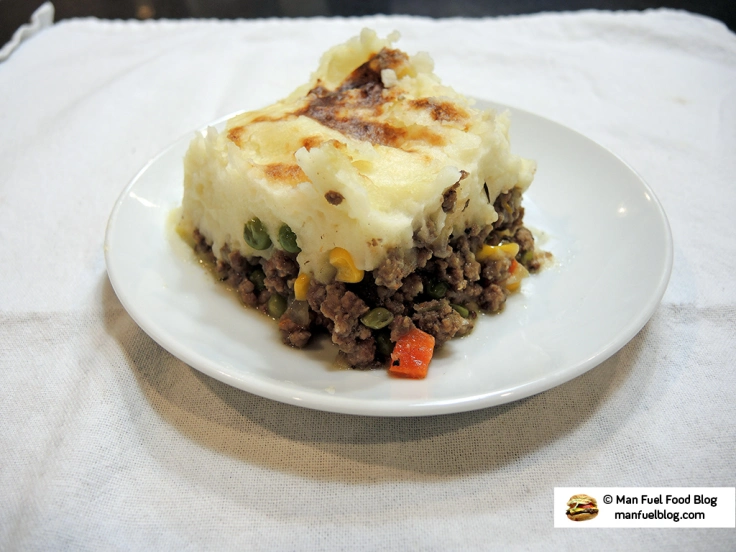Shepherd’s Pie is usually ground beef or other red meat mixed with veg and gravy, topped with mashed potatoes which are lightly browned in the oven. Chicken Pot Pie is made with chicken, veg, and gravy, topped with a crust of some sort. Usually pie crust, but might be puff pastry, or biscuits.

Homemade Shepherd’s Pie (or Cottage Pie)

Shepherds pie with meat, vegetables, and fluffy potatoes.
- Meat Mixture:
- 1 pound of 85/15 ground beef or ground lamb
- 1/2 a large sweet onion, chopped
- 1/2 cup of peas (frozen or fresh)
- 1/2 cup of corn kernels (frozen or fresh)
- 1/2 cup of sliced carrots (frozen or fresh)
- 2 Garlic cloves crushed
- 1 tablespoon loosely packed diced fresh parsley
- 1 tablespoon of vegetable or canola oil
- 1/2 teaspoon kosher salt
- 1/4 teaspoon coarse ground black pepper
- 1 tablespoon of flour
- 1/2 cup of chicken or beef broth
- Potatoes:
- 1.5 pounds of russet potatoes (roughly 3 large potatoes)
- 1/2 cup of milk
- 1/2 cup of heavy cream
- 1/2 stick (4 tablespoons) of butter
- 1/2 teaspoon and 1/2 tablespoon of kosher salt
- Large pan
- Cutting board
- Large pot
- Potato peeler
- Potato ricer or masher
- Rubber spatula / wooden spoon spatula
- Colander
- 2.5 Quart baking dish
- Cup and teaspoon measurements
- Chop and prep all of the vegetables. Chop half an onion into even pieces and get the 1/2 cup each of peas, carrots, and corn ready. For the peas and corn, frozen are fine and work very well. For the carrots, I personally prefer to use fresh ones because they look nicer and taste sweeter, but frozen will work as well if you don’t feel like peeling and cutting. I like to crush the garlic using a garlic press, but finely chopped garlic work as well.
- Fill a large pot with water and set it on the stove.
- Peel and cut three good-sized russet potatoes into quarters or sixth and drop them in the water. It’s important that the potatoes go into the water before it’s hot or boiling!
- Bring the pot with the potatoes in it up to a medium boil and then add in the 1/2 tablespoon of salt. Let them boil for roughly 20 minutes until they’re fork-tender.
- While the potatoes cook, set a large pan on the stove, set the heat to medium, and add a tablespoon of oil to the pan. Once the pan starts to get hot, add the ground meat and brown it in the pan until most of the moisture has evaporated. Note: If you find that your ground meat has browned (or become grayish) and it’s still swimming in liquid your pan may not have initially been hot enough, so just drain off some of the liquid to prevent the meat from steaming.
- Next, add in the onions and saute them with the meat until they start to get just a little softer before adding the rest of the vegetables. Mix and incorporate the ingredients together. Note: At this stage, if you want to make something a little different, you can add some other spices to the meat, like curry powder or herbs to give the whole dish some new life!
- When all of the vegetables have softened, but aren’t mushy, sprinkle a tablespoon of flour over the mixture along with a 1/2 teaspoon of salt and a 1/4 teaspoon of pepper. Mix everything very well. The flour will help thicken the mixture for the next step.
- Add a 1/2 cup of chicken broth to deglaze the pan that will create a little bit of moisture and gravy for the dish.
- When the meat and broth have all mixed well and the broth is hot, transfer the meat mixture to a 2.5 quart baking dish and let it cool a bit.
- While the meat cools, pre-heat the oven to 400 degrees F and work on the potatoes. When they’re fork-tender, drain the potatoes in a colander and return them to the pot they were in.
- Use a potato ricer (recommended for fluffy potatoes) or a potato masher (recommended for thicker potatoes) and press or mash the potatoes until they are just all broken down. Don’t overdo it because if you mash them too much, they’ll become pasty.
- Cut up 4 tablespoons (half a stick of butter) into small cubes and toss them into the potatoes. Fold (don’t mash!) the potatoes so that the butter starts to melt from the heat of the potatoes. A rubber spatula works very well for folding potatoes. Note: Another way to change up the usual Shepherd’s Pie is to infuse the potatoes with some new flavors like cheese, diced scallion/chives, or curry powder. Experimentation can keep this often overlooked dish, fun and creative!
- Next add in a 1/2 cup of whole milk, a 1/2 cup of heavy cream, and 1/2 teaspoon of salt. Fold the potatoes until everything is well incorporated. Try not to mash the potatoes or stir them too much. They should end up fluffy and soft. They might seem too soft at first, but once they’re baked, they’ll stiffen up a bit more.
- Scoop out enough of the potatoes to spread them evenly over the meat mixture. Be careful not to mix them in with the meat because you want two layers, not one big mixture.
- Place the baking dish into the 400 degree F oven for 20 minutes on the middle rack. Then turn the broiler to high and place the baking dish under it for roughly 3 minutes. Be careful not to burn the top. The goal is just to get some nice golden brown notes.
- Let the Shepherd’s Pie sit for 10 to 15 minutes before serving and then enjoy!
Please Support Home Is A Kitchen!
No spam. Just real updates on recipes, restaurant reviews, travel, and free giveaways!
Chicken Pot Pie vs. Shepherd’s Pie: What’s The Difference? (Recipes and More!)
FAQ
What is the difference between a pie and a pot pie?
What makes a pot pie a pot pie?
What’s the difference between shepherd’s pie and meat pie?
What is a shepherds pie called when it is made from beef?
Are mashed potatoes on a shepherd’s pie the same as a pot pie?
The mashed potatoes on a shepherd’s pie form a “topping” or “crust,” but there is traditionally no actual pastry, which is a clear distinction between the shepherd’s pie and the pot pie. Furthermore, most shepherd’s pies are made with beef, pork, or lamb, while the majority of pot pies are made with chicken.
What is the difference between a shepherd’s pie and a chicken pot pie?
Another distinction is the gravy or sauce. While a shepherd’s pie is often teeming with a brown, beef stew-like concoction under its mashed potato hat, a chicken pot pie is usually marked by a white, rich sauce that ensconces the chicken, peas, carrots, and other vegetables.
What is the difference between Shepherd’s pie & cottage pie?
It just comes down to what kind of ground meat you use. Shepherd’s Pie is traditionally made with ground lamb while it’s more well-known and oft-mistaken cousin, Cottage Pie, is made with ground beef. That’s it. Some people are sticklers for the difference, but most people just call either version Shepherd’s Pie.
Are there vegetarian versions of Shepherd’s pie?
Nowadays, there are even vegetarian or vegan versions, variations with cheese, and some with pie crust. What are the differences? The mashed potatoes on a shepherd’s pie form a “topping” or “crust,” but there is traditionally no actual pastry, which is a clear distinction between the shepherd’s pie and the pot pie.
